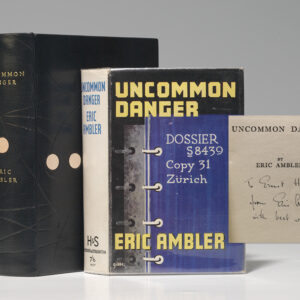Description
AN EXTRAORDINARY CENTERPIECE OF ANY INSCRIBED COLLECTION: “WILL YOU DO ME THE FAVOR TO ACCEPT MY OWN COPY OF A BOOK FOR WHICH I HAVE A PARTICULAR AFFECTION?”: VERY RARE SPECIALLY BOUND PRESENTATION FIRST EDITION OF DICKENS’ DAVID COPPERFIELD, BOLDLY INSCRIBED AND SIGNED BY DICKENS, WITH AN EXTRAORDINARY PRESENTATION AUTOGRAPH LETTER SIGNED BY DICKENS REFERRING TO THE BOOK
DICKENS, Charles. David Copperfield. WITH: Autograph letter signed. London: Bradbury and Evans, 1850. Octavo, contemporary three-quarter red morocco for presentation, black morocco spine labels, marbled boards, endpapers renewed. Autograph letter laid in, (one sheet of 7 by 9-inch paper, folded once, written on two pages. Housed in a custom full morocco slipcase.
First edition in book form of Dickens’ personal favorite of all his novels, with engraved frontispiece and 38 plates by H. K. Browne—very rare and desirable presentation copy bound for the author and inscribed by him to J.L. Rickards on the dedication leaf: “J.L. Rickards Esquire From Charles Dickens, Tavistock House, Thirty First May, 1854.” Together with an autograph letter from Dickens to Rickards of the same date, describing the presentation of this, his own personal copy: “Dear Sir, I wish to preserve between us some little outward and visible remembrance of your generous Mexican adventure – the adventure for which I was unconsciously responsible. Will you do me the favor to accept my own copy of a book for which I have a particular affection? In the assurance that you will like it none the worse for coming from my study shelves. I beg you to accept it with my thanks and good wishes. Faithfully yours Charles Dickens.”
Madeline House, of University College, Cambridge and one of the scholars preparing the Pilgrim Edition of Dickens’s letters, wrote to Brett E. Lanstaff at John F. Fleming, Inc. that it is possible that this John Rickards is he who lived off St. John’s Wood Road, close to Joseph King’s school which Dickens’s two eldest sons attended. “It seems to us possible that John Rickards was an Assistant Master at Joseph King’s school, and that there Dickens met him. (His later disappearance from London Directories could mean that he had now moved into the school – or gone to Mexico!) He turns up again, this time in Brighton, where, at the age of 72, he died in 1858…” Ms. House surmises that the “Mexican adventure” may refer to an educational activity: “The harsh pictures Dickens had drawn of certain schools may well have had a profound effect on Rickards, and in this way Dickens had been ‘unconsciously responsible’ for a ‘generous Mexican [educational] adventure’ undertaken by Rickards. We discovered in the British Museum a pamphlet in Spanish on ‘the Lancastrian System’ of teaching in schools, as tried in Mexico – the date of the pamphlet being 1854 (the date of your Dickens letter). Rickards is not mentioned in the pamphlet by name; yet the coincidence of date, an English system being tried in Mexico, and your letter, makes me hopeful that this is a solution to the problem.” This letter was published in the Pilgrim Edition of the Letters (page 344).
The most autobiographical of all of Dickens’s novels, David Copperfield had enormous personal importance to its author. Many of the most painful episodes of his life were only thinly veiled in the book, leading Dickens to speak of the difficulty of “dismissing some portion of himself into the shadowy world.” In his preface to the later 1869 edition, Dickens made explicit his feelings for the book: “Of all my books, I like this the best. It will be easily believed that I am a fond parent to every child of my fancy, and that no one can ever love that family as dearly as I love them. But, like many fond parents, I have in my heart of hearts a favourite child. And his name is David Copperfield.”
Dickens’s presentation bindings vary in format: some are recorded in green or red morocco, either half or full bindings; others are in full polished calf. Where the binder is identified, it is usually James Hayday. The decoration on the very earliest bindings was sometimes ornate, but by the highpoint of Dickens’s career in the 1850s they were relatively understated half bindings, usually of red morocco like this. This copy has a lengthy provenance and was evidently examined enthusiastically over the years and stored without adequate protection; as a result, some plates had become oxidized, brittle, and the first plate had severe chipping at the edges. The engraved frontispiece, two title pages, and two plates have been supplied from another first edition copy; the original damaged plates have been retained separately and are included. Eckel, 77. Sadleir 686. Smith I:9. Provenance: J.L. Rickards (presentation inscription from the author and letter from Dickens laid-in); Thomas Jefferson McKee (bookplate; his sale part IV, Anderson, 3 December 1901, lot 4983); Thomas E. Stillman (1837–1906, bookplate); Henry C. Taylor (1894–1971, bookplate); Kenyon Starling to William E. Self (bookplates); Pierre Bergé (book label).
Letter silked on verso, split at fold. Plates generally browned at margins, as usual, text generally clean, repaired tear to page 9/10; very minor rubbing to extremities of morocco binding. An extremely good copy, exceptionally rare and desirable presented and boldly signed by Dickens, with an exceptional autograph letter referring to his “particular affection” for this book.




